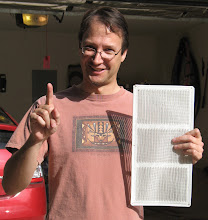To answer that question, let's take a look at a graph that plots what I'm interested in (energy usage), vs. the thing that I thing most influences it (CDD's) for both my starting year 2005, and the year we're analyzing, 2007. The graph below has been smoothed by Excel to make the curves easier to follow.
 What a fascinating result! The larger, blue "loop" is the 2005 data, and the smaller "green" loop below it is the 2007 data. A few things jump out immediately:
What a fascinating result! The larger, blue "loop" is the 2005 data, and the smaller "green" loop below it is the 2007 data. A few things jump out immediately:- The relationship between kWh and CDDs is not as simple as might be hoped
- As expected, the green loop does not extend as far to the right, since a cooler summer caused there to be fewer CDDs in 2007
- As expected, the green loop does not extend as high as the blue loop, since we know we used less energy in 2007
- The graph indicates a hysteresis, or memory, is at work in our system. We know this because for any given X value, there tends to be more than 1 Y value, and you would need to know more about the system to determine which Y value to use.
We learned all that from simply looking at the graph! Truly, a picture is worth at least 1000 words.
To verify that the hysteresis is caused by what I think it is, I should be able to look at the raw data and determine that for each year, the lower half of the curve occurs in January-June, and the upper half in July-December. Wondrous to see, I have looked, and it does indeed. If you follow the data points making up each year, you start at the left in January, move across the bottom of the loop going rightward until about the peak is reached in July or August, then move back across the top of the loop during the last few months of the year.
One thing that this complex graph tells me is that it won't be fully accurate to just estimate a slope for each of those loops and compare those slopes to determine the effectiveness of my home improvements to 2007. Nevertheless, I can do it, so I will. Again using simple features in Excel, I come up with the following "best fit" lines for each loop.
 Looking at the slope of each of these "best fit" lines will give me a rough idea how well my improvements in 2007 had improved my situation regardless of the weather changes. The numbers?
Looking at the slope of each of these "best fit" lines will give me a rough idea how well my improvements in 2007 had improved my situation regardless of the weather changes. The numbers?2005 Slope: 2.8 kWh/CDD
2007 Slope: 1.1 kWh/CDD
This is yet another fascinating result! To the extent that it is accurate, I had already increased the energy-effectiveness of the cooling of my house by some 60% in 2007, yet my energy usage had dropped only some 43% over the same time. Perhaps that makes some sense: I had only improved the cooling-related energy use, and not any other aspect of energy use. Since the cooling-related energy use was reduced due to the cloudy summer in 2007, and that's the only part that I optimized, perhaps the overall savings should be less than 60%.
However, this analysis remains unsatisfying. Looking at the 2nd graph above, the linear fit is just a really poor estimate of the actual function we're graphing. Clearly, the memory at play in the system is significant, and perhaps I can find a way to account for it.
In the meantime, I need to finish the analysis to account for the radiant barrier added later in 2007 and 2008. Read on to fulfill your curiosity!


No comments:
Post a Comment